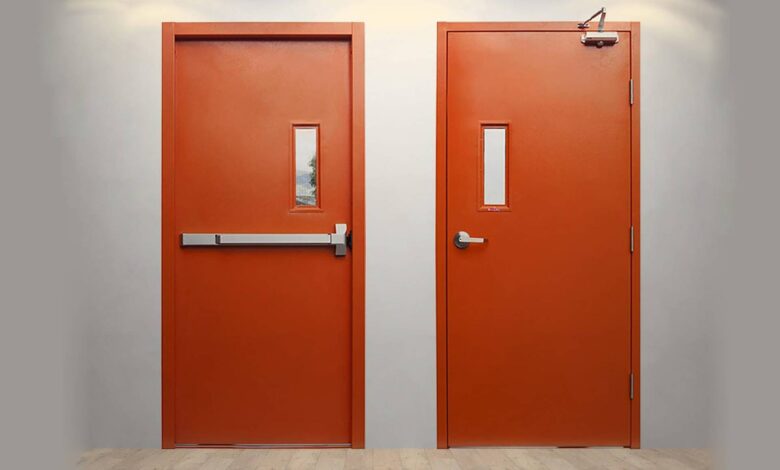Unlocking the Secrets of Metal Fire Doors: Essential Information You Need to Know

What Makes a Fire Door Different from a Regular Door?
Fire-rated doors are designed to resist heat as well as the spread of flames and smoke during a fire. These doors help compartmentalize a building, providing critical time for safe evacuation and emergency response. They are important for safety and meeting compliance with legal requirements concerning fire resistance in specific parts of a structure, as well as in zoned areas of a building. Fire rated doors are used in commercial and industrial buildings and even in residential complexes where adherence to fire safety regulations is mandatory.
For more in-depth information, you should view the metal fire door – YK
How Advanced Materials and Techniques Achieve Fire Resistance in Metal Doors
The fire resistance in metal doors is achieved through the use of advanced materials and precise manufacturing techniques. Usually, the doors are constructed with a solid core consisting of fire-resistant steel or a composite gypsum-steel core. The door frame, hardware, seals, and hinges are specially designed to sustain extreme temperatures while maintaining the structural integrity of the door. Many metal fire doors are put through rigorous testing under standards such as UL 10C or NFPA 252 to certify their fire-resistance rating, which can range from 20 minutes to several hours. This rating indicates the duration and conditions under which the door can withstand fires.
View metal fire door for sale – YK for More Details
The Significance of Fire-Rated Glass in Improving Safety
Fire-rated glass can be added to metal fire doors for both safety and visibility purposes, and it fits perfectly without weakening the fire resistance of the door. This glass is specifically designed to withstand extreme temperatures while remaining intact when exposed to fire, making it protective against smoke and flames. Certain variants of fire-rated glass offer insulation that can reduce the transfer of heat to the non-fire side of the building. Fire-rated glass, which is manufactured using layers of laminated glass, ceramic, or intumescent materials, undergoes stringent testing for safety compliance and is often used in windows located in high-visibility areas like exits and corridors. When paired with fire doors, fire-rated glass adds to the architectural elegance while still providing robust safety features alongside strong metal construction.
What materials are used to manufacture metal fire doors?
The Durability of Steel and Hollow Metal Doors
Steel and hollow metal doors are favored for their remarkable durability and strength, which makes them suitable for fire-rated applications. Steel, as a material, bends, warps, or succumbs to high temperatures less than other materials, providing consistent performance during fires. Hollow metal doors with reinforced cores are better at fire resistance since the reinforced core reduces heat transmission as well as strengthens the integrity of the door. These doors are often coated with fire-resistant finishes, which offer additional protection while maintaining a refined look appropriate for numerous architectural settings.
Exploring Composite and Ceramic Options
Composite and ceramic materials help to further improve the fire resistance of metal fire doors. Composite cores made of fire-rated minerals and gypsum or other suitable composites perform better than traditional materials, thus reducing the temperature within the premises. Used along with fire-rated glass, ceramic materials improve the door’s ability to endure extreme heat while staying translucent for sight. These and other options allow flexibility for strict compliance with fire safety regulations while observing functional and aesthetic requirements.
The Importance of Frame and Hinge Components
The effectiveness of any fire-rated door is directly determined by the standard of its frame and hinge components, alongside their compatibility. Door frames must be made from steel or reinforced aluminum to ensure that they are mechanically stable, as well as thermally stable, during severe conditions. Hinges and other hardware are critical in maintaining door alignment and functionality during a fire. Fire-rated hinges are usually made from reliable metals that endure high temperatures without deforming or failing. Proper integration of these components ensures the door serves its core purpose of acting as a barrier that enhances protection and containment during emergencies.
How to Select the Right Fire Door for Your Building?
Key Factors in Selecting a Fire Door
Evaluating a fire door’s construction entails measuring zoning dimensions that are specific to your building. Fire doors are designed to provide optimal sealing to avert fire breaches, and as such, must be housed in a carefully calibrated frame. Off-the-shelf sizes will work for the vast majority of cases, but buildings with peculiar layouts or irregular openings might need bespoke door dimensions. Furthermore, the door’s functionality should complement the design of the building’s fireproofing features in addition to its other purposes, such as sound and temperature regulation.
Standard vs. Custom Options in Commercial Doors
To cater to commercial spaces and ensure safety compliance, pre-designed fire doors are readily available, making them a preferred choice for most standard buildings. These off-the-shelf models come with short lead times and are easy to install. On the other hand, custom fire doors are specifically designed for a given building’s needs, like larger openings, distinct architectural shapes, or multi-functionality that requires additional safety performance features. Even though bespoke options might require longer to manufacture and come at an increased price, they are more flexible to meet personalized requirements while maintaining safety and compliance standards.
Choosing your door in compliance with set standards and regulations
The matching of fire doors is critical to their selection, and local industry standards and fire regulations should be considered. A number of UL, NFPA, EN standards, and others issue fire resistance ratings, materials, and test specifications for a fire door, so this should also be taken into consideration. Local building codes should be reviewed in order to comply with the minimum fire rating required for certain zones in your building. Choosing a fire door that is certified to these standards and above ensures compliance and offers the best protection during a fire.
What are the Installation Requirements for Metal Fire Doors?
Critical Steps in the Installation Process: Ensuring Fire-Rated Door Efficiency and Security
Below are the critical steps to follow:
- Check Your Certification Compliance: For the fire door and frame, check that they are compliant with needed certifications prior to installation. Also, confirm that the fire rated credentials of the doors and frames are correct. They should not be below the fire rating your building requires. Check the labels and documentation for compliance with UL, NFPA or other applicable codes.
- Check the Door Opening: Ensure that the fire door will fit in an appropriately shaped square opening, clear of any obstructions. Check that it is. The opening must be plumb and level.
- Install the Door Frame: Install the door frame into the opening and fix it in place with fasteners recommended by the manufacturer’s instructions. Ensure the door frame is aligned appropriately with the wall and include fireproof caulking or seals where needed.
- Hang the Door: Use the door-hinges or pivots as indicated by the manufacturer to fix the door onto the frame. Install hardware on the door which is fire rated and tested to be compatible with fire-rated assemblies.
- Install Fire-Rated Hardware: Equip the door with certified fire-rated hinges, locks, closers, and latches. In a condition where the door and frame fails and tries to operate freely during a fire and the direction of the fire, it shouldn’t easily lose its integrity.
- Seal Gaps and Clearances: Check if the tolerances between the door and frame, as well as between the door and floor, comply with fire rating standards. Apply fire protective seals or intumescent strips where applicable.
- Verify Operation and Testing: Fire doors should be checked after installation to ensure they function correctly, including smooth operation, self-closing, and latching. Carry out all tests as per manufacturer’s suggestions or local regulations to ensure compliance.
Common Installation Mistakes to Avoid
The improper installation of a fire door could seriously affect its functioning. The following mistakes should be scrupulously avoided:
- Using Non-Compliant Materials: The installation of uncertified door hardware or the use of non-rated components and materials nullifies the certification and operational integrity of the fire door. Use only the materials and certified products specified.
Incorrect Clearances: Excessive or uneven gaps between the door and the frame allow fire, smoke, and heat to leak through, thus limiting its efficacy. Measure and adjust the door and frame carefully during installation.
Poor Alignment: Doors or frames that are misaligned may prevent proper closing and latching, which is vital for fire containment. Be sure to mount the frame and hang the door with precision.
Skipping Regular Inspections: Placing the door and frame under no check for any damage or improper installation may render a grave deficiency unnoticed. Conduct thorough inspections both during and after installation.
Missing or Damaged Seals: The omission of intumescent seals or installing damaged seals negates the purpose of the door to stop the spread of fire and smoke. Thoroughly inspect the seals and replace them if necessary.
How Do Metal Fire Doors Enhance Safety and Security?
The Role of Fire-Rated Doors in Fire Protection
Fire-rated doors are one of the means of Fire and Life Safety used to restrict the spread of fire and smoke within the built environment, therefore safeguarding the building’s occupants and their belongings. These doors are able to withstand intense heat for a set time, which normally can range between 20 minutes and several hours, depending on their fire rating. Fire-rated doors create spatial compartments in the event of a fire, which limits damage and provides the utmost evacuation time. The efficiency of these doors in acting as fire protection depends a lot on their correct installation, upkeep, and compliance with the local fire safety codes.
How Commercial Metal Doors Secure Properties
Commercial metal doors serve the purpose of ensuring property security beyond fire safety. Made of sturdy materials like steel or galvanized iron, they provide significant resistance against forcible entry and vandalism. Entrance strength, tamper-resistant locking systems ensure the security of storage areas, sensitive offices, or the building’s perimeters. Commercial metal doors are made to suit particular security needs- these might include bullet-proof or blast-proof ones for higher-level protection.
Additional Safety Features of Fire-rated Doors
Modern fire-rated doors incorporate many advanced features for property safety. For instance, some have smoke seals that prevent harmful gases from passing through so that there is breathable air for evacuation. Vision panels with fire-resistant glazing allow for inspections to be carried out beyond the doors prior to opening, hence enhancing situational awareness. Automatic door closers and linkage with the building fire alarm system ensure that the fire-rated door opens or closes at the right time during an emergency. With all these features combined, fire-rated doors can be treated as active safety devices, apart from being referred to as a passive safety measure in an overarching property safety plan.




